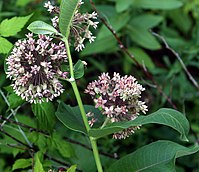Forb

Aforborphorbis anherbaceousflowering plantthat is not agraminoid(grass,sedge,orrush). The term is used inbotanyand in vegetationecologyespecially in relation tograsslands[1]andunderstory.[2]Typically these aredicotswithout woody stems.
Etymology[edit]
The word "forb" is derived fromGreekphorbḗ(φορβή), meaning "pasture"or"fodder".[3][4]The Hellenic spelling "phorb" is sometimes used, and in older usage this sometimes includesgraminidsand other plants currently not regarded as forbs.
Guilds[edit]
Forbs are members of aguild—a group of plant species with broadly similar growth form.[5]In certain contexts in ecology, guild membership may often be more important than thetaxonomicrelationships between organisms.

In informal classification[edit]
In addition to its use in ecology, the term "forb" may be used for subdividing popular guides towildflowers,[6]distinguishing them from other categories such as grasses, sedges,shrubs,andtrees.[7]Some examples of forbs areclovers,sunflowers,daylilies,andmilkweed.
Forb Adaptation Zones: Kale and turnip are examples of forb adaptations distributed over much of Europe, southern Oceania, northern Asia, and northern North America. In cooler climates, these crops are grown year-round, while in warmer climates, they are used as winter forage.
Examples[edit]
Linnaean taxonomyfamilynames are given.[8] Acanthaceae, Aizoaceae, Amaranthaceae, Apiaceae, Apocynaceae, Asclepiadaceae, Asteraceae, Balsaminaceae, Begoniaceae, Boraginaceae, Brassicaceae, Buxaceae, Campanulaceae, Cannabaceae, Caryophyllaceae, Chenopodiaceae, Clusiaceae, Convolvulaceae, Crassulaceae, Cucurbitaceae, Cuscutaceae, Dipsacaceae, Ericaceae, Euphorbiaceae, Fabaceae, Gentianaceae, Geraniaceae, Gunneraceae, Haloragaceae, Hydrophyllaceae, Lamiaceae, Lentibulariaceae, Limnanthaceae, Linaceae, Lythraceae, Malvaceae, Moraceae, Nyctaginaceae, Onagraceae, Orobanchaceae, Oxalidaceae, Papaveraceae, Phytolaccaceae, Plantaginaceae, Plumbaginaceae, Polemoniaceae, Polygonaceae, Portulacaceae, Primulaceae, Ranunculaceae, Resedaceae, Rosaceae, Rubiaceae, Scrophulariaceae, Solanaceae, Thymelaeaceae, Urticaceae, Valerianaceae, Verbenaceae, Violaceae, Zygophyllaceae
See also[edit]
- Dicotyledon– Historical grouping of flowering plants
- Herbaceous plant– Plant that has no persistent woody stem above ground
- Overgrazing– When plants are grazed for extended periods without sufficient recovery time
- Tapestry lawn
References[edit]
- ^Schröder, Hans (2009).Grasslands: Ecology, Management and Restoration.Commack, N.Y: Nova Science Publishers.ISBN978-1-60692-024-4.
- ^"Native Understory Forbs and Grasses".nrcs.usda.gov.Archived fromthe originalon 2022-03-08.Retrieved2021-05-02.
- ^Jaeger, Edmund C.(1959).A source-book of biological names and terms.Springfield, Ill: Thomas.ISBN0-398-06179-3.
- ^Scott, Robert Pickett; Henry, George (2007).Liddell and Scott's Greek-English Lexicon, Abridged: Original Edition, republished in larger and clearer typeface.Simon Wallenburg Press.ISBN978-1-84356-026-5.
- ^Roxburgh, Stephen.A Demonstration of Guild Based Assembly Rules for a Plant Community and Determination of Intrinsic Guilds.
- ^"Wildflower seeds and forbs".graniteseed.Retrieved2021-05-02.
- ^"Describe the major differences between the plant families used as forages".Forage Information System.2009-05-28.Retrieved2021-05-02.
- ^"Invasive Plant Atlas".Retrieved25 Sep2021.
External links[edit]
- United States Department of AgricultureNatural Resources Conservation ServicelinktoGrowth habitsCodes and Definitions.
